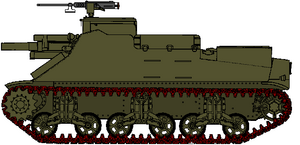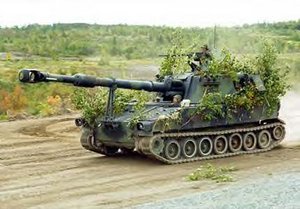|
|
|
|
|
Self Propelled Guns Self-Propelled Guns were a unique type of vehicle developed during the Second World War, referring specifically to the mounting of an artillery piece (gun) to a motorized vehicle, generally a fully-tracked and armoured one. The Germans developed many types of these vehicles, not only using them as mobile artillery, but also as sturmgeschützen ("assault guns") in which they were used in a direct fire role as infantry support. Later in the war, Panzerjäger (literally "tank hunter" but translated more accurately as "anti-tank") vehicles mounted high-velocity anti-tank guns as a defence against the growing number of Allied tanks. Self-propelled guns were relatively less expensive to build than a tank, as the main distinction between the two was the lack of a rotating turret. Some SPs were open-topped, others featured an armoured roof. Canadian UsageThe Canadian Army used SPs in the same manner as the British Army, as a mobile field artillery piece. Artillery doctrine that both armies shared described a reliance on concentrated firepower. The use of SPs as direct fire weapons, be it against infantry or armour, was not seriously contemplated. The main justification for the expense of mobilizing artillery in this manner was the ability to keep up with fast-moving armoured formations; for that reason field regiments in armoured divisions were self-propelled. The 3rd Canadian Infantry Division's field regiments also converted to self-propelled regiments for the assault phase of the Normandy invasion in June 1944. Self-propelled anti-tank guns were also used during the Second World War and into the 1950s by the Canadian Army. Priest The first SP the Canadians would use in action was the US M7 Priest, so called because of the "pulpit"-like circular anti-aircraft machine gun mount. The Priest carried a 105mm howitzer which used 7 different propellent charges (compared to the four of the Canadian 25-pounder Gun. No firm establishment for these vehicles was laid out, but many of these vehicles (loaned from the US Army before the Normandy Landing) were issued to the three field regiments of the 3rd Canadian Infantry Division (as well as two others). On 1 Dec 1943, there were 60 Priests held by the Canadian Army in Europe. Delays in obtaining the vehicles had resulted when some were sent to the Mediterranean. By the end of Feb 1944, however, all five self-propelled regiments were fully equipped.1 The Priests of the divisional artillery were withdrawn by August 1944 to be replaced with towed 25-pounder guns as per the normal practice for an infantry division. A total of 72 of these Priests were converted into Kangaroo armoured personnel carriers in Aug 1944. The Priest was also used in Italy, where the 8th Field Regiment, RCA (of the 5th Canadian (Armoured) Division) received 24 vehicles in April 1944 and was still using them at the end of the year. SextonThe Canadian Sexton entered service in Sep 1943, a combination of the 25-pounder Gun and the chassis of the Canadian Ram tank. The vehicle was characterized by right-hand drive and modifications to the gun (notably the recoil system) to get the gun properly fitted. They were used widely throughout 21st Army Group after Jul 1944. The Sexton was open-topped, with 38mm of frontal armour. Some 2,150 Sextons had been built by the time production at the Montreal Locomotive Works ceased in 1945. The Sexton continued in use until the 1950s. Equipment: Armament - 25-pounder Gun (field sighting gear), 2 machine carbines, 2 Bren Guns, 2 rifles. Observation - telescope, protectoscope. Communiction - No. 19 Wireless Transmitter set, amplifier, loudspeaker, cable for Observation Post, signal pistol. Tools, spares, rations, etc. Armour thickness: upper hull front 3/4", upper hull sides 1/2", upper hull rear 1/2". Lower hull runs 2-1/2".
M10 Two variants of the US M10 were used in Canadian service. In US service, the vehicle was known as the M10 Gun Motor Carriage and mounted a high-velocity 3-inch (76mm) gun for anti-tank work. US doctrine divided armoured vehicles into "tanks" and "tank destroyers", the M10 being a form of the latter. It was used in Canadian service armed with both the 76mm gun and the more effective 17-pounder, and was issued at anti-tank regiments as part of divisional artillery. The British acquired over 1,600 M10s, and rearmed about 1,000 of these with the 17-pounder. The standard complement of self-propelled anti tank guns was two batteries per anti-tank regiment in armoured divisions and anti-tank regiments held at corps level as corps troops. Canadian formations in the UK were up to strength by the end of Feb 1944, and forces in Italy were so equipped by Apr 1944.2 The 3rd Canadian Infantry Division's anti-tank regiment received one troop per battery of M10s as well, for the assault landing in Normandy in Jun 1944. The division was to replace its SPs with towed 6- and 17-pounders after the assault phase, but in the actual event, 17-pounder M10s were provided to replace the 3-inch armed M10s originally issued. One battery of M10s (the 56th Anti-Tank Battery of the 2nd Canadian Infantry Division employed in Operation TOTALIZE "had been given extra protection for the (crew) by welding on a lid of armour-plate to prevent mortar bombs from entering the fighting compartments. The lids were constructed with a movable flap which could be folded back to give the No. 1 full view when required; when down it afforded complete protection from anything except an artillery shell."3
Used by anti-tank regiments in armoured divisions and corps troops. Two batteries of the armoured division's anti-tank regiment were so equipped, primarily to provide anti-tank support to the armoured brigade. Equipment: Armament - 3-inch gun (field sighting gear), .50 calibre machine gun, .45 calibre sub machine gun, rifles. Observation - 3 periscopes, telescopic sight. Communication - No. 19 Wireless Transmitter set, interphone, cable for Observation Post, signal pistol. Spares, tools, rations, etc. Power is provided by two engines, fuel and oil capacities are given for total. Open-topped vehicle, armour on turret shield 2-1/4", turret sides 1", hull front 1-1/2", hull sides 1".
 Used by anti-tank regiments in armoured divisions and corps troops. Two batteries of the armoured division's anti-tank regiment were so equipped, primarily to provide anti-tank support to the armoured brigade. Equipment: Armament - 17-pounder (field sighting gear), .45 calibre sub machine gun, smoke mortar, rifles. Observation - periscopes, binoculars, telescopic sight. Communication - No. 19 Wireless Transmitter set, interphone, signal pistol. Spares, tools, rations, etc. Power is provided by two engines, fuel and oil capacities are given for total. Open-topped vehicle, armour on turret shield 2-1/4", turret sides 1", hull front 1-1/2", hull sides 1".
Archer At least one anti-tank regiment made use of the Archer self-propelled anti-tank gun (photos of the 7th Anti-Tank Regiment, RCA using the Archer in Italy in Oct 1944 are shown in Tools of the Trade).4 The Archer was a variant of the Valentine tank armed with a 17-pounder gun. The vehicle was unique in having a rear-facing main armament, allowing the vehicle to be driven directly out of a firing position. The vehicle was small, but cramped (the driver had to vacate his seat when the gun was in operation lest he be seriously injured by the gun's recoil). The first production models were issued in Mar 1944, and a total of 665 were built. The gun had 11° of traverse, 15° of elevation and 7½° of depression. The vehicle had stowage for 39 rounds of ammunition. Armour ranged from 60-80mm and the vehicle had a crew of 4.5
Archers of the 2nd Anti-Tank Regiment, Royal Canadian Artillery, taking part in a parade marking the handing-in of the guns of the 2nd Canadian Infantry Division near Oldenburg, Germany, 15 May 1945. LAC Photo. M109 The M109 self-propelled howitzer became the primary armament of the Royal Regiment of Canadian Artillery in 1968 and served in that capacity into the 21st Century. By 1971, a total of 76 vehicles had been acquired and were used at various land force bases, primarily CFB Shilo, MB; CFB Valcarier, PQ; CFB Petawawa, ON; and CFB Gagetown, NB as well as with 4 CMBG. While the M109 was the largest armoured fighting vehicle ever fielded by the Canadian Army, the vehicle's weight was reduced by the use of welded aluminium armour on both hull and turret. The vehicles were over 27 feet long with a weight of 25,000 kg. The M109 had a crew of six:
The vehicle was armed with an M185 155mm cannon (a hybrid gun-howitzer) capable of direct or indirect fire and characterized by a large muzzle brake and prominent bore evacuator. The semi-automatic breech was of screw block type which opened using the recoil forces of the gun itself. Recoil was adjusted hydraulically. The vehicle was stabilized during firing by two retractable spades on the rear corners of the hull. Standard NATO 155mm ammunition of separate-loading type was used, and the gun was fired by cartridge primers. The vehicle had internal stowage for 36 rounds. The vehicle also mounted a .50 calibre machine gun on the commander’s cupola for self-defence. The M109 was air-transportable.
The vehicle's range was 220km on good surfaces with a maximum speed of 53 kph on roads. The vehicle was powered by a front-mounted, turbocharged 295kW Detroit Diesel 8V71T engine driving an Allison XTG-411 transmission.
TOW Under Armour
ADATS
Ammunition:
Notes
|
© canadiansoldiers.com 1999-present













